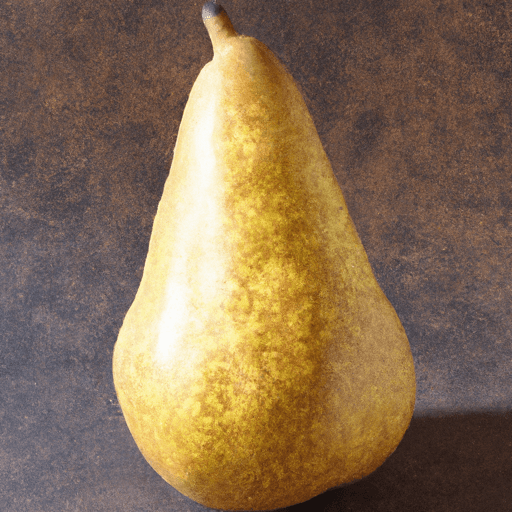The Delightful Bosc Pear: A Sweet and Versatile Delicacy
Pears have always been a favorite fruit for many, thanks to their delicate texture and sweet yet slightly tart flavor. Among the vast array of pear varieties, one that stands out with its unique blend of flavors and versatility in cooking is the exquisite Bosc pear.
A Taste of Pure Honey
The Bosc pear is renowned for its exceptional taste. With an exceptionally sweet and juicy flesh, it is often described as having a flavor reminiscent of pure honey. However, what truly sets the Bosc pear apart is its distinct aroma. As the pear ripens, it develops a heavenly fragrance that enhances its already delightful taste.
Culinary Delights
Thanks to its firm and dense texture, the Bosc pear is a culinary staple that can be used in a multitude of delightful dishes. It excels in both sweet and savory preparations, making it an incredibly versatile ingredient.
Sweet Delights
In desserts and baked goods, the Bosc pear can truly shine. Its firm flesh holds up well in the heat, making it a perfect addition to pies, tarts, and even crumbles. Poaching Bosc pears in a syrup infused with warming spices, such as cinnamon and star anise, gives them a tender texture and an intensified flavor, making them a perfect topping for cakes or an indulgent treat on their own.
Savory Sensations
The Bosc pear’s unique taste and texture also make it a wonderful component in savory dishes. It pairs beautifully with creamy cheeses like blue cheese or goat cheese in salads or on a cheeseboard. Its slight tartness adds a refreshing twist to salads, while its firm texture holds up well when roasted alongside pork tenderloin or glazed with savory sauces.
The Nutritional Powerhouse
In addition to its incredible taste and culinary versatility, the Bosc pear is also packed with essential nutrients. Pears, including the Bosc variety, are a fantastic source of dietary fiber, aiding in digestion and maintaining overall gut health. They are also an excellent source of Vitamin C, which boosts the immune system and supports collagen production.
A Fascinating History
The Bosc pear has a rich history that adds to its allure. Originating in France in the early 19th century, it was named after M. Bosc, the famed French horticulturist who discovered and cultivated it. Since then, Bosc pears have gained popularity worldwide, and their unique attributes have made them a favorite among chefs and food enthusiasts alike.
The Bosc pear truly is a remarkable fruit. Its succulent flesh, reminiscent of pure honey, offers a delightful experience in both sweet and savory dishes. Its versatility in the culinary world knows no bounds, making it a fantastic addition to any kitchen. Not only does it taste heavenly, but it also provides essential nutrients, contributing to a balanced and wholesome diet. So, next time you visit your local grocery store or farmers market, be sure to pick up some Bosc pears and embark on a flavorful journey in your own kitchen.
Bosc Pears
Origin: Bosc pears, also known as Doyenne du Comice, were first discovered in France in the 19th century. They were then brought to the United States in the early 1800s. Nowadays, Bosc pears are primarily grown in the Pacific Northwest region of the United States.
Common Uses: Bosc pears are versatile fruits that can be enjoyed in various ways. They have a firm and dense texture, making them suitable for both raw and cooked applications. Bosc pears are often enjoyed fresh as a snack, added to salads, or used in desserts such as pies, tarts, and crumbles. They are also known to have a sweet and aromatic flavor when baked or poached.
Nutritional Benefits: Bosc pears offer several nutritional benefits. They are a good source of dietary fiber, providing around 6 grams per medium-sized pear. They also contain essential vitamins and minerals, including vitamin C, vitamin K, potassium, and copper. Additionally, Bosc pears are low in calories, with one medium-sized pear containing approximately 120 calories.
Unique Properties: Bosc pears are known for their distinct shape and appearance. They have a long, slender neck and a rounded bottom. The skin of Bosc pears is golden-brown, often with patches of russeting or speckles. Their flesh is ivory-white and has a slightly grainy texture. Bosc pears are also known for their ability to maintain their shape when cooked, making them ideal for baking and poaching.
Historical Significance: Bosc pears have a rich history, dating back to their discovery in France. The name “Doyenne du Comice” translates to “Top of the Show” and reflects the high regard with which this variety is held. Bosc pears gained popularity in the United States during the 1800s and have since become a staple in American orchards and kitchens. They are often sought after for their unique flavor and texture, making them a favorite among many culinary enthusiasts.




Use the share button below if you liked it.
It makes me smile, when I see it.